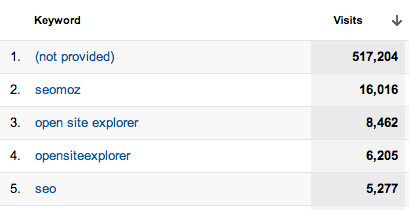
Marketing Analytics and the Problem of Attribution Modeling
The author's views are entirely their own (excluding the unlikely event of hypnosis) and may not always reflect the views of Moz.
Guys, we need to talk about attribution modeling. It’s a hot issue in our industry and most of us (SEOmoz included) aren't doing it as well as we want to be. It's tough stuff. Mike P from Distilled gave a great MozCon presentation on the topic, but most of us aren't anywhere close to that sophisticated - and even his model is impacted by Google Analytics' limitations.
It’s been covered in far more detail elsewhere, but in a nutshell: attribution modeling attempts to solve the problem of which channel gets credit when a user touches multiple channels prior to converting. Many marketers simply throw up their hands and say the last touch gets all the credit – but then we have to live with the knowledge that some of our efforts are far more effective than we give them credit for.
Not-so-super modeling

Supermodel by Soggydan on Flickr
Unfortunately, attribution modeling is very hard to do well for a lot of reasons:
- Any site to which users return daily (like, for example, SEOmoz.org) quickly fills up with touches that may or may not be related to conversions.
- Channels like social media and community building are often a first touch but rarely the only touch before conversion, meaning they tend to get less credit than they deserve.
- Attributing offline sales to online efforts can be very painful, not to mention tracking one user’s conversion path as she uses multiple devices during her buying decision.
- In our post-Panda world, we’re spending a ton of time and effort on content that may end up on third party sites, opening us up to the near-impossible task of tracking view-through conversions.
In my opinion, however, the biggest problem with the attribution models available to us today is that their roots lie in web analytics tools like Google Analytics. This means that attribution models tend to be biased toward on-site efforts. The bulk of our marketing efforts doesn’t happen on-site, so why should our measurement? Our competitors certainly aren’t doing things on our site, so why should we content ourselves with on-site data?
Web-analytics-based attribution models also tend to break up sources at the channel level: organic search, social media, direct traffic, etc. Anyone who’s worked for months on driving traffic from Twitter and then had one tweet from Rand break their site can tell you not all social media touches are created equal, so why lump them all into Social Media?
.jpg)
Finally, attribution models are incredibly difficult to implement for success metrics beyond conversion (more on that later).
Marketing analytics is about campaigns, not channels
Here at the MozPlex, we’ve been talking a lot about marketing analytics: the way we measure and optimize our marketing activities. I think Joanna put it best in her post: “Marketing analytics is the act of looking past mere website results, and asking yourself, ‘How did that marketing campaign really go?’”
Marketing analytics means going beyond the data we can get from our web analytics tool so you can measure off-site and even offline activities. Capturing that additional data about how your off-site and on-site marketing activities are performing allows you to test with greater confidence, and as marketers, we should always be testing. It’s probably not as simple as “social media doesn’t drive as many conversions as organic search.” Instead, we can test how to spend our time and money - which levers to pull at which time and in which way - to attract, keep, and delight our customers. At the same time, we can take a cross-channel, holistic view of our efforts to see what messages are resonating best.
All conversions aren’t created equal
Of course, one thing we want to do with our marketing efforts is make more money. ROI-driven modeling is always going to be part of what we’re measuring. However, modern marketers are driving for more than just the lead or the sale or the free trial. We’re looking at micro-conversions like newsletter signups. We’re watching and participating in conversations about our brand. We’re investing in customer happiness. We’re tracking shares, tweets, mentions, and views – and we’re keeping an eye on how are competitors are doing, too.
In addition to major conversions, marketing analytics is about tracking customer loyalty.

Forever Friends by dprotz, on Flickr
We can often gain as much revenue from keeping our existing customers happy as from getting new ones. What happens after the conversion?
Marketing analytics is also about tracking brand identity. This is becoming more and more important as the major search engines focus more and more on brand strength as a quality indicator. This is another area where typical attribution models just don’t go far enough. Brand-centric campaigns are as much about generating conversation and positive feelings as they are about directly causing more conversions – this makes it harder to prove value if conversions are your only KPI. Branding has an influence on direct traffic, but it also has a big influence on organic search traffic from branded keywords.

So, should that traffic still count as organic search, if branding efforts are what inspired the search in the first place? This is another area where a more campaign-centric view can provide more insight than simply attributing conversions to channels.
Getting closer to marketing analytics
We’re still in the early days of true marketing analytics, which means we’re still mashing up data from a bunch of different tools and struggling to find the right ways to track campaigns. In the meantime, we can start hacking our web analytics’ attribution monitoring tools to go beyond simple channel attributions:
Advanced metrics for attribution modeling
- Top referrers (separated out from the rest of referral traffic)
- Top keywords (separated out from the rest of the keywords)
- Long-tail keywords (same deal)
- Top partners and/or affiliates
- (not provided) search traffic
- Branded and non-branded search traffic
- Individual social networks (A friend and a follower may not be the same!)
- Individual feeds
- Individual paid advertising sources
We can also start thinking of (and tracking) our data with a marketing analytics mindset:
Advanced metrics for marketing analytics
- Messages
- Type of touch (Branding? Promotion? Retention? Happiness?)
- Type of product
- Audience
- Time of day
- Conversations
In the end, marketing analytics is more useful than straight-up attribution modeling, because it allows you to view your marketing efforts holistically. When you view individual customer touches as part of a larger whole instead of siloed by medium, you can take a longer and more customer-driven view of your marketing efforts.



Comments
Please keep your comments TAGFEE by following the community etiquette
Comments are closed. Got a burning question? Head to our Q&A section to start a new conversation.